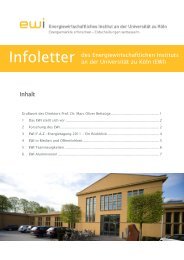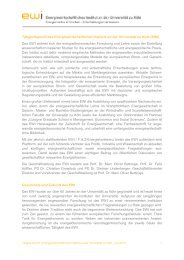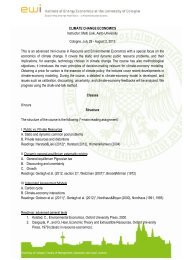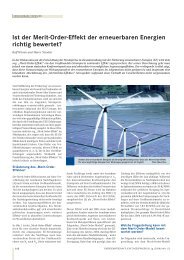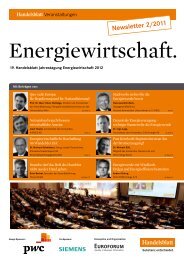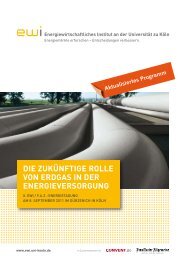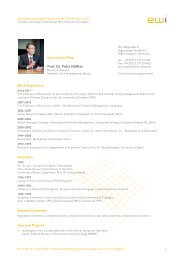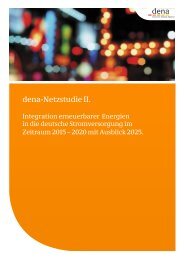From Nodal to Zonal Pricing – A Bottom-Up Approach to the Second ...
From Nodal to Zonal Pricing – A Bottom-Up Approach to the Second ...
From Nodal to Zonal Pricing – A Bottom-Up Approach to the Second ...
Create successful ePaper yourself
Turn your PDF publications into a flip-book with our unique Google optimized e-Paper software.
<strong>From</strong> <strong>Nodal</strong> <strong>to</strong> <strong>Zonal</strong> <strong>Pricing</strong> <strong>–</strong><br />
A Bot<strong>to</strong>m-<strong>Up</strong> <strong>Approach</strong> <strong>to</strong> <strong>the</strong> <strong>Second</strong>-Best<br />
Preprint<br />
BARBARA BURSTEDDE (EWI)<br />
EWI Working Paper, No 12/09<br />
July 2012<br />
Institute of Energy Economics at <strong>the</strong> University of Cologne (EWI)<br />
www.ewi.uni-koeln.de
Institute of Energy Economics<br />
at <strong>the</strong> University of Cologne (EWI)<br />
Alte Wagenfabrik<br />
Vogelsanger Straße 321<br />
50827 Köln<br />
Germany<br />
Tel.: +49 (0)221 277 29-100<br />
Fax: +49 (0)221 277 29-400<br />
www.ewi.uni-koeln.de<br />
BARBARA BURSTEDDE<br />
Institute of Energy Economics at <strong>the</strong> University of Cologne (EWI)<br />
Tel: +49 (0)221 277 29-309<br />
Fax: +49 (0)221 277 29-400<br />
Barbara.Burstedde@ewi.uni-koeln.de<br />
ISSN: 1862-3808<br />
The responsibility for working papers lies solely with <strong>the</strong> authors. Any views expressed are<br />
those of <strong>the</strong> authors and do not necessarily represent those of <strong>the</strong> EWI.
Abstract<br />
<strong>From</strong> <strong>Nodal</strong> <strong>to</strong> <strong>Zonal</strong> <strong>Pricing</strong> -<br />
A Bot<strong>to</strong>m-<strong>Up</strong> <strong>Approach</strong> <strong>to</strong> <strong>the</strong> <strong>Second</strong>-Best ✩<br />
Barbara Burstedde<br />
Institute of Energy Economics at <strong>the</strong> University of Cologne<br />
Vogelsanger Str. 321, 50827 Koeln, Germany<br />
Congestion management schemes have taken a prominent place in current<br />
electricity market design discussions. In this paper, <strong>the</strong> implications of<br />
establishing zonal pricing in Europe are analyzed with regard <strong>to</strong> potential<br />
zonal delimitations and associated effects on <strong>to</strong>tal system costs. Thereby, a<br />
nodal model sets <strong>the</strong> benchmark for efficiency and provides high-resolution<br />
input data for a cluster analysis based on Ward’s minimum variance method.<br />
The proposed zonal configurations are tested for sensitivity <strong>to</strong> <strong>the</strong> number of<br />
zonesandstructuralchangesin<strong>the</strong>electricitymarket. Fur<strong>the</strong>rmore, dispatch<br />
and redispatch costs are computed <strong>to</strong> assess <strong>the</strong>costs of electricity generation<br />
and transmission. The results highlight that suitable bidding zones are not<br />
bound <strong>to</strong> national borders and that losses in static efficiency resulting from<br />
<strong>the</strong> aggregation of nodes in<strong>to</strong> zones are relatively small.<br />
JEL classification: C38, C63, L51, Q41<br />
Keywords: Cluster Analysis, Electricity Market Modeling, <strong>Nodal</strong> <strong>Pricing</strong>,<br />
Redispatch, <strong>Zonal</strong> <strong>Pricing</strong><br />
✩ A previous version of this paper was presented in May 2012 at <strong>the</strong> 9 th International<br />
Conference on <strong>the</strong> European Energy Market, held in Florence, Italy.<br />
Email address: barbara.burstedde@ewi.uni-koeln.de (Barbara Burstedde)<br />
Preprint July 30, 2012
Nomenclature<br />
¯d Mean of dk<br />
¯pi,k Mean vec<strong>to</strong>r of prices in cluster i at stage k<br />
bn,m Binary parameter indicating neighboring nodes n, m<br />
Ci,k Cluster i at step k<br />
dk Critical distance at clustering step k<br />
Ei,k Sum of squared Euclidean distances of cluster i at step k<br />
Ik Feasible set of clusters at step k<br />
k Clustering step k ∈ [1,...,N −1]<br />
n Node n ∈ [1,...,n,m,...,N]<br />
pn Price vec<strong>to</strong>r of node n<br />
sd Standard deviation of dk<br />
1. Introduction<br />
On <strong>the</strong> way <strong>to</strong> <strong>the</strong> internal electricity market (IEM) special attention is<br />
paid <strong>to</strong> possible advancements in congestion management schemes. Important<br />
improvements have already been made by <strong>the</strong> successive introduction of<br />
implicit auctions of transmission capacities, e.g. in <strong>the</strong> case of <strong>the</strong> Central<br />
Western European (CWE) market coupling between France, <strong>the</strong> BeNeLux<br />
states and Germany. Following this process, <strong>the</strong> scope of <strong>the</strong> discussion has<br />
broadened <strong>to</strong> include national transmission networks as well.<br />
In <strong>the</strong> recently published Framework Guidelines on Capacity Allocation<br />
and Congestion Management for Electricity (CACM, ACER (2011)) <strong>the</strong><br />
Agency for <strong>the</strong> Cooperation of Energy Regula<strong>to</strong>rs (ACER) explicitly recommends<br />
<strong>the</strong> definition of bidding areas or zones whose implementation is<br />
meant <strong>to</strong> support adequate congestion management and <strong>to</strong> contribute <strong>to</strong>wards<br />
locational price signals. Thereby, <strong>the</strong> zonal delimitations shall be<br />
proposed by <strong>the</strong> transmission system opera<strong>to</strong>rs (TSOs) and may span one or<br />
more control areas in case no significant congestion occurs within or between<br />
areas.<br />
However, <strong>the</strong> CACM guidelines do not clarify at which degree of congestion<br />
a bottleneck qualifies as significant. Instead, ACER defines ”overall<br />
market efficiency” as <strong>the</strong> main principle in <strong>the</strong> definition of zones, including<br />
aspects of ”socio economic welfare, liquidity, competition, network structure<br />
and <strong>to</strong>pology, planned network reinforcement and redispatching costs” (cf.<br />
ACER (2011), p. 7). Especially, <strong>the</strong> TSOs’ analysis of zonal delimitations<br />
2
shall be based on detailed data on redispatching costs and structural congestion.<br />
Relevant criteria for <strong>the</strong> evaluation of zonal market configurations<br />
are also discussed in Frontier Economics and Consentec (2011) and Supponen<br />
(2011). In Frontier Economics and Consentec (2011), <strong>the</strong> consequences<br />
of a potential division of <strong>the</strong> German-Austrian bidding zone are analyzed<br />
with regard <strong>to</strong> technical and economic implications. The mainly qualitative<br />
evaluation covers changes in market concentration, liquidity and transactions<br />
costs as well as in static and dynamic market efficiency and is based on a<br />
hypo<strong>the</strong>tical division of <strong>to</strong>day’s market zone in<strong>to</strong> two separate areas along<br />
<strong>the</strong> most critical bottleneck observed in <strong>the</strong> year 2009. On <strong>the</strong> said line, congestion<br />
arises at 10% of <strong>the</strong> hours of <strong>the</strong> year. Supponen (2011) introduces<br />
fur<strong>the</strong>r criteria for <strong>the</strong> choice of bidding zones such as <strong>the</strong> direction of <strong>the</strong><br />
wind power flow and a coincidence of zonal boundaries with physical congestion<br />
points. Finally, a zonal configuration is proposed which divides <strong>the</strong><br />
European market in<strong>to</strong> 45 zones. Thereby, Germany, <strong>the</strong> BeNeLux countries,<br />
France, Austria and Switzerland are assigned <strong>to</strong> 11 zones.<br />
A stronger focus on quantitative measures is put in S<strong>to</strong>ft (1997), Wal<strong>to</strong>n<br />
and Tabors (1996) and Bjørndal and Jørnsten (2001). S<strong>to</strong>ft (1997) states<br />
that <strong>the</strong> definition of zones should be based on nodal price differences which<br />
comprise all relevant information on network related costs. This is underlined<br />
by <strong>the</strong> findings in S<strong>to</strong>ft (1996) which show that <strong>the</strong> loss in welfare by<br />
creating uniformly priced zones despite internal congestion is proportional<br />
<strong>to</strong> <strong>the</strong> squared error in <strong>the</strong> uniform prices. In Green (2007), <strong>the</strong> decrease in<br />
welfare induced by implementing a single price zone instead of nodal pricing<br />
is quantified for <strong>the</strong> English and Welsh system as 1.3% of <strong>the</strong> genera<strong>to</strong>rs’<br />
revenues. Wal<strong>to</strong>n and Tabors (1996) <strong>the</strong>refore combine statistical tests for<br />
price uniformity with information from practical experience <strong>to</strong> identify zones,<br />
but do not formalize a method <strong>to</strong> test <strong>the</strong> results’ adequacy. In Bjørndal and<br />
Jørnsten (2001), <strong>the</strong> authors show that absolute differences in nodal prices<br />
do not yet provide an adequate basis for <strong>the</strong> definition of zones since similar<br />
price differences may lead <strong>to</strong> variations in <strong>the</strong> optimal zonal configurations<br />
in different scenarios. Thus, cluster analysis is suggested as one possible<br />
methodological refinement.<br />
Clusteranalysisisi. a. usedinOlmosandPérez-Arriaga(2008)andYang<br />
et al. (2006). Authors in Olmos and Pérez-Arriaga (2008) apply two clustering<br />
methods, Au<strong>to</strong>regressive Kohonen Maps and <strong>the</strong> k-means algorithm, <strong>to</strong> a<br />
se<strong>to</strong>fpowertransferdistributionfac<strong>to</strong>rs(PTDF)due<strong>to</strong>alackofinformation<br />
needed for nodal price computations. PTDFs give <strong>the</strong> relative impact of a<br />
3
marginal change in <strong>the</strong> net input of a node on any given line in <strong>the</strong> system<br />
and <strong>the</strong>refore do not reflect all relevant information on <strong>the</strong> structure of <strong>the</strong><br />
electricity system. In Yang et al. (2006), a set of potentially congested lines<br />
is identified by <strong>the</strong> means of probability analysis. Then, sensitivities of nodal<br />
power injections <strong>to</strong> <strong>the</strong> flows over <strong>the</strong> congested lines are computed and used<br />
as a substitute for nodal prices in a fuzzy c-means cluster analysis.<br />
The research presented in this paper develops a set of market zones for<br />
<strong>the</strong> CWE region, Switzerland and Austria (CWE+) for both 2015 and 2020<br />
on <strong>the</strong> basis of hourly nodal prices and a hierarchical cluster analysis. Knowing<br />
that zonal pricing is in general <strong>the</strong> second-best solution <strong>to</strong> enhancing<br />
efficiency (see e.g. Hogan (1998)), <strong>the</strong> error made in aggregating nodes in<strong>to</strong><br />
zones is reduced by including as much information on <strong>the</strong> (spatial) market<br />
structure as possible. The underlying methodology is introduced in section 2<br />
while section 3 describes <strong>the</strong> data basis and relevant assumptions. In section<br />
4 <strong>the</strong> results of <strong>the</strong> nodal model and <strong>the</strong> zonal aggregation are discussed.<br />
In order <strong>to</strong> challenge <strong>the</strong> newly defined market zones, <strong>the</strong>ir dispatch and<br />
redispatch is calculated. Thus, <strong>the</strong> change in <strong>to</strong>tal system costs by switching<br />
from <strong>the</strong> first-best nodal solution <strong>to</strong> a zonal system is quantified. Some<br />
implications of <strong>the</strong> gained insights are given in section 5.<br />
2. Methodology<br />
The derivation of market zones and <strong>the</strong> subsequent evaluation of <strong>to</strong>tal<br />
system costs are based on two methodological building blocks. The NEUL-<br />
ING model optimizes <strong>the</strong> European (re-)dispatch for given nodal and zonal<br />
configurations, while <strong>the</strong> latter result from cluster analysis subject <strong>to</strong> a minimum<br />
variance criterion.<br />
2.1. The NEULING Model<br />
The New European Linear Investment and Grid Model (NEULING, cf.<br />
Burstedde (2012)) is used <strong>to</strong> calculate <strong>the</strong> cost-minimal generation dispatch<br />
and redispatch of a given power plant portfolio for 8760 hours of a year. The<br />
high temporal resolution allows for <strong>the</strong> consideration of general structural<br />
patterns such as seasonal variations in load as well as of extreme events.<br />
Thus, an adequate data base for <strong>the</strong> later cluster analysis is generated.<br />
2.1.1. Dispatch and DC-Load-Flow<br />
Thespotmarketdispatchofconventionalpowerplantsisdeterminedsuch<br />
that<strong>the</strong>residualdemand(exogenoussystemdemandincludingnetworklosses<br />
4
less electricity produced by renewable energy sources (RES-E) and less mustrun<br />
generation from combined heat and power plants) is met in each hour.<br />
Fur<strong>the</strong>rmore,<strong>the</strong>demandforpositiveandnegativebalancingreserveneeds<strong>to</strong><br />
becovered. Theconventionalpowerplantfleetincludinghydros<strong>to</strong>rage(Hyd-<br />
S), pumped s<strong>to</strong>rage (Hyd-PS) and compressed air energy s<strong>to</strong>rage (CAES)<br />
plants is grouped in<strong>to</strong> 25 so-called vintage classes according <strong>to</strong> primary fuel,<br />
age and technological characteristics such as efficiency. Each vintage class is<br />
<strong>the</strong>n dispatched under consideration of variable and ramping costs, as well<br />
as minimum- and part-load restrictions.<br />
The cost-minimal nodal dispatch is subject <strong>to</strong> network restrictions implemented<br />
by a DC power flow model as introduced in Schweppe et al. (1988)<br />
and applied e.g. in Leuthold et al. (2008). The DC power flow gives an<br />
approximation of <strong>the</strong> physical flows over <strong>the</strong> high-voltage alternating current<br />
transmission network in <strong>the</strong> so-called core model regions (cf. Schweppe et al.<br />
(1988) for <strong>the</strong> derivation of <strong>the</strong> DC model and Groschke et al. (2009) for a<br />
discussion on optimal power flow models). Thereby, both losses as well as<br />
reactive power are neglected in order <strong>to</strong> keep <strong>the</strong> problem linear. The lines’<br />
physical capacities are standardized and multiplied with a fac<strong>to</strong>r of 0.8 in order<br />
<strong>to</strong> account for a security margin. Fur<strong>the</strong>rmore, interconnec<strong>to</strong>rs <strong>to</strong> and in<br />
between so-called satellite regions are implemented by <strong>the</strong> use of net transfer<br />
capacities (NTC).<br />
2.1.2. Redispatch<br />
The basic spatial resolution of NEULING gives a nodal representation of<br />
<strong>the</strong> core model regions. Depending on <strong>the</strong> object of investigation, <strong>the</strong> nodes<br />
can be aggregated in<strong>to</strong> zones. Although <strong>the</strong> zonal dispatch assumes internal<br />
copperplates, <strong>the</strong> information on <strong>the</strong> nodal net injections is preserved. Thus,<br />
<strong>the</strong> usage of <strong>the</strong> internal grid can be determined ex-post and <strong>the</strong> necessary<br />
redispatchincaseofviolationsofnetworkconstraintscanbecalculatedbased<br />
on <strong>the</strong> plants’ operating status and <strong>the</strong>ir utilization.<br />
The optimal flow-based redispatch is represented by <strong>the</strong> least-cost combinationofupwardanddownwardramping,<br />
whichat<strong>the</strong>sametimerelieves<strong>the</strong><br />
overloaded line and keeps <strong>the</strong> balance between demand and supply at each<br />
node. The marginal costs of a plant’s upward redispatch are given by its<br />
variable fuel and ramping costs, while <strong>the</strong> marginal savings of its downward<br />
redispatch equal <strong>the</strong> avoided costs of generation. This setup corresponds <strong>to</strong><br />
a cost-based mechanism in which <strong>the</strong> genera<strong>to</strong>rs are ei<strong>the</strong>r compensated or<br />
charged as <strong>to</strong> render <strong>the</strong>m indifferent with regard <strong>to</strong> being redispatched.<br />
5
In <strong>the</strong>ory, <strong>the</strong> nodal injections after cost-based redispatch correspond <strong>to</strong><br />
those of <strong>the</strong> optimal nodal dispatch if no additional restrictions on technical<br />
flexibility apply and <strong>the</strong> plants’ cost functions are identical in dispatch and<br />
redispatch(cf. Hermansetal.(2011)). Inthiscase, <strong>the</strong><strong>to</strong>talcostsofbothdesigns<br />
are equal. However, this assumption is not trivial. Due <strong>to</strong> <strong>the</strong> time lag<br />
between day-ahead dispatch and redispatch <strong>the</strong> technical restrictions on <strong>the</strong><br />
latter are tighter, thus increasing <strong>the</strong> variable costs of generation. Fur<strong>the</strong>rmore,<br />
intraday trade requires costly adjustments of <strong>the</strong> redispatch schedule<br />
on short notice.<br />
In <strong>the</strong> presented approach, redispatch is priced with <strong>the</strong> hourly variable<br />
costsof<strong>the</strong>dispatch. Fur<strong>the</strong>rmore, <strong>the</strong>sametechnicalflexibilityasin<strong>the</strong>dispatch<br />
is assumed, with <strong>the</strong> exception of limiting quick starts of non-spinning<br />
units<strong>to</strong>opencyclegasturbines(OCGT)andhydropower. Bothassumptions<br />
underestimate <strong>the</strong> true costs of redispatch by trend. However, redispatch is<br />
modeled by <strong>the</strong> hour such that ramping costs are overestimated in comparison<br />
<strong>to</strong> an intertemporal optimization. This is especially true if structural<br />
congestion requires continuous redispatch.<br />
2.2. Cluster Analysis<br />
In multivariate statistics, cluster analysis is used <strong>to</strong> group variables with<br />
multiple observations according <strong>to</strong> <strong>the</strong> variables’ similarity. Two prominent<br />
model-classes are connectivity-based and centroid-based clustering, which<br />
differ in <strong>the</strong>ir basic definition of similarity (refer <strong>to</strong> Handl (2010) for an introduction).<br />
ConnectivitymodelsrelyonmetricssuchasEuclideandistances<br />
between <strong>the</strong> variables’ observations <strong>to</strong> identify clusters in a hierarchical process.<br />
Thus, clusters are merged in <strong>the</strong> order of increasing distances (agglomerative<br />
clustering) or split in <strong>the</strong> order of decreasing distances (divisive). As<br />
a result, <strong>the</strong> number and composition of clusters are given subject <strong>to</strong> critical<br />
distance levels. Hierarchical models are complemented by various algorithms<br />
which allow for different linkage criteria. The best choice of an algorithm<br />
finally depends on <strong>the</strong> structure of <strong>the</strong> given data set. Instead of explicitly<br />
evaluating distances between variables, centroid-based clustering defines<br />
cluster centers and measures <strong>the</strong> distance of <strong>the</strong> data points <strong>to</strong> <strong>the</strong> centers.<br />
Each variable is <strong>the</strong>n grouped <strong>to</strong> <strong>the</strong> nearest center, which is not necessarily<br />
an element of <strong>the</strong> original data set. Most of <strong>the</strong> associated heuristic k-means<br />
algorithms require an ex-ante specification of <strong>the</strong> number of cluster centers<br />
k, whose location is <strong>the</strong>n optimized. Fur<strong>the</strong>rmore, <strong>the</strong> result are sensitive <strong>to</strong><br />
<strong>the</strong> given starting points of <strong>the</strong> centers’ locations.<br />
6
Since<strong>the</strong>goalof<strong>the</strong>presentedresearchis<strong>to</strong>identifystructuraldifferences<br />
between price regions as well as <strong>the</strong> loss of information produced by merging<br />
zones, <strong>the</strong> leaps in critical distance levels between clustering steps contain<br />
valuable information which is easily provided by agglomerative hierarchical<br />
methods. Fur<strong>the</strong>rmore, <strong>the</strong> desired number of price zones cannot be specified<br />
beforehand. Thus, <strong>the</strong> continuous computation of optimal clusters for<br />
each possible level of aggregation provides <strong>the</strong> complete range from which<br />
<strong>to</strong> choose in only one model run. In consequence, a hierarchical model is<br />
applied.<br />
The input data for <strong>the</strong> cluster analysis is provided by NEULING and<br />
consists of 8760 observations of marginal costs of generation for each node.<br />
Since an aggregation of nodes is supposed <strong>to</strong> yield homogeneous zones in<br />
terms of absolute height of and variation in marginal costs, Ward’s minimum<br />
variance criterion (cf. Ward (1963)) is implemented. At each clustering step<br />
k ∈ [1,...,N−1] where N equals <strong>the</strong> number of nodes, <strong>the</strong> algorithm merges<br />
two classes such that <strong>the</strong> resulting increase in in-cluster variance is minimal.<br />
At <strong>the</strong> beginning of each step, <strong>the</strong> sum of squared Euclidean distances Ei,k<br />
between <strong>the</strong> price vec<strong>to</strong>rs pn of each node n ∈ [1,...,N] and <strong>the</strong> cluster Ci,k’s<br />
mean vec<strong>to</strong>r ¯pi,k is calculated, if n is an element of <strong>the</strong> set Ci,k representing<br />
<strong>the</strong> i th cluster at stage k:<br />
Ei,k = <br />
n∈Ci,k<br />
(pn − ¯pi,k) ′ (pn − ¯pi,k). (1)<br />
Ei,k is thus a measure for <strong>the</strong> homogeneity of a cluster and is equal <strong>to</strong><br />
zero at <strong>the</strong> starting point where every node forms a separate cluster. The<br />
measure for <strong>the</strong> quality of <strong>the</strong> complete cluster set is given by <strong>the</strong> sum of<br />
Ei,k over all clusters i at stage k. In consequence, <strong>the</strong> optimal configuration<br />
of clusters is chosen as <strong>the</strong> combination that yields <strong>the</strong> minimal decrease in<br />
quality:<br />
<br />
arg minIk∆ := Ei,k − <br />
i∈Ik<br />
j∈Ik−1<br />
Ej,k−1. (2)<br />
Here, Ik represents a feasible cluster set at <strong>the</strong> k th stage of <strong>the</strong> algorithm.<br />
Thereby, only combinations of neighboring nodes give valid clusters. The<br />
latter restriction is implemented in an additional constraint that includes a<br />
binary parameter bn,m which is equal <strong>to</strong> 1 if <strong>the</strong> nodes n and m are adjacent,<br />
and zero o<strong>the</strong>rwise.<br />
7
The result of <strong>the</strong> hierarchical clustering can be fur<strong>the</strong>r evaluated by analyzing<br />
<strong>the</strong> critical distances at which two clusters are merged, i.e. <strong>the</strong> sum<br />
of all optimal E ∗ i,k over i. These distances are denoted by dk. In order <strong>to</strong><br />
identify <strong>the</strong> ideal level of aggregation, Mojena (1977) proposes a benchmark<br />
based on <strong>the</strong> normalized measure<br />
ˆdk = dk − ¯ d<br />
which increases mono<strong>to</strong>nically over k and where ¯ d is <strong>the</strong> mean over all<br />
dk and sd is <strong>the</strong> standard deviation of dk. Based on simulations, Milligan<br />
and Cooper (1985) recommend <strong>to</strong> choose <strong>the</strong> previously optimized cluster<br />
set containing N + 1 − k ∗ clusters, where k ∗ is determined by <strong>the</strong> index of<br />
<strong>the</strong> first cluster step at which ˆ dk > 1.25 holds.<br />
3. Data and Parametrization<br />
The regional coverage used in <strong>the</strong> model runs is given in figure 1. The<br />
core regions Austria, Switzerland, Germany, <strong>the</strong> Ne<strong>the</strong>rlands, Belgium and<br />
France are divided in<strong>to</strong> 72 basic regions, which each represent one node of<br />
<strong>the</strong> DC network. The shape of <strong>the</strong> regions is chosen <strong>to</strong> best reflect <strong>the</strong> grid<br />
structure, but also considers <strong>the</strong> boundaries of national administrative areas.<br />
Adjacent countries are modeled as national, one-node regions.<br />
The network structure as well as relevant technical parameters such as<br />
line resistance, reactance and capacity are provided by <strong>the</strong> Institute for Energy<br />
Systems, Energy Efficiency and Energy Management (ie 3 ) at TU Dortmund<br />
University. Planned grid extensions are considered on <strong>the</strong> basis of <strong>the</strong><br />
Ten-Year Network Development Plan provided by <strong>the</strong> European Network of<br />
Transmission System Opera<strong>to</strong>rs for Electricity (ENTSO-E (2010)). In <strong>to</strong>tal,<br />
NEULING’s DC load-flow simulates <strong>the</strong> optimal power flow between<br />
79 nodes via 434 lines (2015) and 446 lines (2020) respectively. Additionally,<br />
<strong>the</strong> NTC values of interconnec<strong>to</strong>rs <strong>to</strong> and between satellite regions are<br />
implemented according <strong>to</strong> ENTSO-E.<br />
The power plant database of <strong>the</strong> Institute of Energy Economics at <strong>the</strong><br />
University of Cologne (EWI) provides geo-coded data of <strong>the</strong> existing and<br />
planned European conventional generation capacities, including expected decommissioning<br />
dates. The installed capacities per main technology are given<br />
on a national level in table 1. Fuel and CO2 price assumptions are based on<br />
EWI (2011) and given in table 2.<br />
8<br />
sd<br />
(3)
Figure 1: Regional coverage of NEULING<br />
Source: Own illustration.<br />
The data on conventional plants is supplemented by location-specific capacities<br />
of renewable energy sources for all core regions which have been<br />
researched for <strong>the</strong> purpose of this study. The location of <strong>to</strong>day’s capacities,<br />
regional potentials and his<strong>to</strong>ric regional developments are used <strong>to</strong> allocate<br />
<strong>the</strong> forecasted installations given in <strong>the</strong> EU-wide National Renewable Energy<br />
Action Plans (NREAP, cf. EC (2010)). The feed-in structure of wind<br />
and solar power is derived from locational hourly data on wind speeds and<br />
solar radiation provided for <strong>the</strong> year 2008 (cf. EuroWind (2011) and figure<br />
2). Thus, <strong>the</strong> concurrence of power generation between regions and between<br />
RES-technologies is consistent. <strong>From</strong> <strong>the</strong> given data, <strong>to</strong>tal electricity production<br />
from RES is calculated as <strong>to</strong> match <strong>the</strong> values given in <strong>the</strong> NREAP.<br />
Regional load data is derived from information on regional electricity<br />
demand or population and its future development. Total demand includes<br />
network losses and is assumed according <strong>to</strong> EURELECTRIC (2011). Aggregated<br />
data on RES and demand is given in table 3.<br />
9
Table 1: Installed Generation Capacities in 2015 and 2020 per Main Technology<br />
[MW] Nuclear Lignite Hard Coal Gas Oil Hyd-S Hyd-PS CAES<br />
AT<br />
2015<br />
2020<br />
0<br />
0<br />
300<br />
300<br />
470<br />
470<br />
5,020<br />
5,960<br />
450<br />
370<br />
3,490<br />
3,490<br />
4,140<br />
4,500<br />
0<br />
0<br />
CH<br />
2015<br />
2020<br />
3,220<br />
2,860<br />
0<br />
0<br />
0<br />
0<br />
900<br />
1,270<br />
10<br />
0<br />
7,050<br />
7,050<br />
3,380<br />
4,980<br />
0<br />
0<br />
DE<br />
2015<br />
2020<br />
12,050<br />
8,100<br />
18,950<br />
17,490<br />
27,080<br />
29,070<br />
20,770<br />
18,450<br />
0<br />
0<br />
230<br />
230<br />
7,630<br />
9,630<br />
320<br />
320<br />
NL<br />
2015<br />
2020<br />
450<br />
450<br />
0<br />
0<br />
9,560<br />
9,560<br />
20,910<br />
19,650<br />
160<br />
160<br />
0<br />
0<br />
0<br />
0<br />
0<br />
0<br />
BE<br />
2015<br />
2020<br />
5,560<br />
3,840<br />
0<br />
0<br />
1,940<br />
1,670<br />
5,910<br />
5,440<br />
50<br />
50<br />
0<br />
0<br />
1,180<br />
1,180<br />
0<br />
0<br />
FR<br />
2015<br />
2020<br />
63,130<br />
59,550<br />
0<br />
0<br />
7,060<br />
5,340<br />
8,800<br />
8,720<br />
6,340<br />
1,570<br />
10,390<br />
10,390<br />
5,510<br />
5,510<br />
0<br />
0<br />
Source: Own calculation based on EWI power plant database.<br />
Table 2: Fuel and CO2 Price Assumptions<br />
[EUR/MWhth] Uranium Lignite Hard Coal Nat. Gas Oil<br />
2015 3.60 1.40 13.20 25.70 47.20<br />
2020 3.60 1.40 13.40 28.10 50.25<br />
CO2 2015: 22.00 EUR/tCO2, 2020: 35.00 EUR/tCO2<br />
4. Results and Discussion<br />
Source: EWI (2011).<br />
In <strong>the</strong> following section, <strong>the</strong> results of NEULING and of <strong>the</strong> cluster analysis<br />
are presented. The first scenario year discussed in detail is 2015. The<br />
stabilityof<strong>the</strong>resultsis<strong>the</strong>ncontrolledforbyacomparisonwithcalculations<br />
for <strong>the</strong> year 2020. This relates <strong>to</strong> <strong>the</strong> CACM guidelines, which propose a regular<br />
assessment of zonal delimitations every two years. Regarding <strong>the</strong> effort<br />
of market participants <strong>to</strong> prepare for changes in zonal definitions, Frontier<br />
Economics and Consentec (2011) suggest a time frame of five years between<br />
thosemodifications. Fur<strong>the</strong>rmore,anauxiliaryscenarioinwhichaflow-based<br />
market coupling of national copperplates is implemented provides a fur<strong>the</strong>r<br />
benchmark.<br />
10
Figure 2: Regional wind speeds onshore and global solar irradiation in <strong>the</strong> core regions<br />
4.1. <strong>Nodal</strong> Dispatch<br />
Source: Own illustration based on EuroWind (2011).<br />
As a first result of <strong>the</strong> nodal dispatch calculations, <strong>the</strong> generation mix<br />
for <strong>the</strong> years 2015 and 2020 is given in figure 3, both for core and satellite<br />
model regions. The characteristics of <strong>the</strong> respective national power plant<br />
fleets translate in deviations in <strong>the</strong> use of primary fuels.<br />
Table 4 gives an overview of <strong>the</strong> demand-weighted average marginal-costbased<br />
prices (AMC) in 2015, both for <strong>the</strong> nodal model and a flow-based<br />
coupling of <strong>the</strong> national copperplates (CU). In each case, <strong>the</strong> marginal prices<br />
comprise generation- and network-based costs. The only difference between<br />
<strong>the</strong> calculations consists in <strong>the</strong> assumptions concerning <strong>the</strong> transmission capacities<br />
between <strong>the</strong> core regions. In <strong>the</strong> nodal model, <strong>the</strong> full network as<br />
described in section 3 is implemented. In contrast, <strong>the</strong> underlying assumption<br />
in <strong>the</strong> national model is that network capacities within countries are<br />
abundant.<br />
On a national level, both <strong>the</strong> demand-weighted average nodal costs as<br />
11
Table 3: Total Consumption and Electricity Production from RES per Technology in 2015<br />
and 2020<br />
[TWh] Consumption RES-E (Total)<br />
Hydro Biomass Solar<br />
Wind<br />
Onshore<br />
Wind<br />
Offshore<br />
O<strong>the</strong>r<br />
AT<br />
2015<br />
2020<br />
70.8<br />
77.0<br />
28.5<br />
29.0<br />
19.7<br />
19.8<br />
4.8<br />
5.2<br />
0.2<br />
0.3<br />
3.8<br />
3.8<br />
0.0<br />
0.0<br />
0.0<br />
0.0<br />
CH<br />
2015<br />
2020<br />
64.3<br />
65.1<br />
18.1<br />
18.5<br />
17.6<br />
17.6<br />
0.0<br />
0.0<br />
0.4<br />
0.6<br />
0.2<br />
0.3<br />
0.0<br />
0.0<br />
0.0<br />
0.0<br />
DE<br />
2015<br />
2020<br />
546.7<br />
524.4<br />
158.6<br />
217.7<br />
19.4<br />
20.1<br />
42.3<br />
49.8<br />
26.2<br />
41.5<br />
62.2<br />
72.9<br />
8.0<br />
31.8<br />
0.4<br />
1.7<br />
NL<br />
2015<br />
2020<br />
126.7<br />
139.2<br />
27.5<br />
50.3<br />
0.2<br />
0.7<br />
13.4<br />
16.6<br />
0.3<br />
0.6<br />
9.5<br />
13.4<br />
4.2<br />
19.0<br />
0.0<br />
0.0<br />
BE<br />
2015<br />
2020<br />
100.2<br />
113.9<br />
13.1<br />
23.1<br />
0.4<br />
0.4<br />
6.0<br />
11.0<br />
0.6<br />
1.1<br />
2.1<br />
4.3<br />
4.0<br />
6.2<br />
0.0<br />
0.0<br />
FR<br />
2015<br />
2020<br />
513.9<br />
533.4<br />
67.6<br />
104.7<br />
23.5<br />
23.2<br />
10.5<br />
17.2<br />
2.6<br />
5.9<br />
22.7<br />
39.9<br />
8.0<br />
18.0<br />
0.3<br />
0.5<br />
Source: Own calculation based on EURELECTRIC (2011), EC (2010).<br />
Figure 3: Annual electricity generation in <strong>the</strong> nodal model in <strong>the</strong> years 2015 and 2020 per<br />
country and technology<br />
Source: Own calculation.<br />
well as <strong>the</strong> average marginal costs of <strong>the</strong> copperplates are ra<strong>the</strong>r homogeneous<br />
such that <strong>the</strong> maximum difference between countries amounts <strong>to</strong> no<br />
12
Table 4: Average marginal costs (AMC) of electricity supply in 2015<br />
[EUR/MWhth] AT CH DE NL BE FR<br />
<strong>Nodal</strong> <strong>Pricing</strong><br />
AMC 53.65 53.52 51.74 53.27 53.54 51.54<br />
Min. AMC 45.24 52.83 50.05 49.95 53.19 50.80<br />
at Node Tauern Chamoson Roehrsdorf Eemshaven Avelgem Bordeaux<br />
Max. AMC 55.51 54.93 52.88 58.01 54.18 52.92<br />
at Node Wien Sils Eichstetten Vierverlaten Gramme Sierentz<br />
National Market Coupling (Copperplate)<br />
AMC 51.72 52.98 52.04 52.58 53.30 50.72<br />
Source: Own calculation.<br />
more than 2.11 EUR/MWh and 2.58 EUR/MWh respectively. Fur<strong>the</strong>rmore,<br />
<strong>the</strong> comparison shows that national marginal costs of supply are by trend<br />
lower in <strong>the</strong> CU than in <strong>the</strong> nodal model. In <strong>the</strong> given set-up, this result is<br />
straight forward: Since <strong>the</strong> CU computation is less restrictive, it allows for<br />
<strong>the</strong> realization of greater efficiency gains from international trade. Thereby,<br />
<strong>the</strong> observed homogeneity of <strong>the</strong> copperplates’ marginal costs implies a high<br />
degree of interconnection between <strong>the</strong> national markets. 1 At <strong>the</strong> same time,<br />
<strong>the</strong> deviations between <strong>the</strong> nodal and <strong>the</strong> CU set-ups already hint <strong>the</strong> relevance<br />
of costs of congestion in evaluations of <strong>to</strong>tal costs of electricity supply,<br />
at least as long as national copperplates are fiction ra<strong>the</strong>r than fact.<br />
The true impact of regional constraints is revealed by <strong>the</strong> differences in<br />
<strong>the</strong> nodal distribution of marginal costs as shown in table 4. While on a<br />
national level <strong>the</strong> average marginal costs of electricity supply are mostly<br />
lower in <strong>the</strong> CU calculation, average marginal prices at some locations in<br />
<strong>the</strong> nodal case clearly undercut <strong>the</strong> former. On <strong>the</strong> one hand, this is due<br />
<strong>to</strong> <strong>the</strong> fact that locational marginal prices reflect <strong>the</strong> flow-based effect of a<br />
change in <strong>the</strong> nodal net input on congested lines. In case <strong>the</strong> effect is relieving,<br />
<strong>the</strong> node’s marginal network costs are negative and reduce <strong>the</strong> overall<br />
price. Analogously, a congestion aggravating effect is associated with positive<br />
costs. Both kinds of externalities are ignored in <strong>the</strong> CU case. On <strong>the</strong><br />
o<strong>the</strong>r hand, differences in marginal prices reflect variations in <strong>the</strong> generation<br />
mix at each node including <strong>the</strong> contribution of RES, as well as locational<br />
1 The Ten Year Network Development Plan (ENTSO-E (2010)) as implemented in <strong>the</strong><br />
analysis assumes grid extensions between <strong>the</strong> countries of <strong>the</strong> CWE region, Austria and<br />
Switzerland of 8.9 GW between <strong>the</strong> years 2010 and 2015.<br />
13
demand. As a result of both effects, <strong>the</strong> difference between <strong>the</strong> overall maximum<br />
AMC (Vierverlaten, NL) and <strong>the</strong>ir minimum (Tauern, AT) amounts <strong>to</strong><br />
12.77 EUR/MWh on average. While <strong>the</strong> generation in Tauern is exclusively<br />
hydro-based, <strong>the</strong> only power plants available at Vierverlaten are gas-fired.<br />
Additionally, Vierverlaten is a net-importing node with a disadvantageous<br />
position in <strong>the</strong> network. But even <strong>the</strong> deviations in marginal cost-based<br />
prices of nodes within one country can be substantial. Due <strong>to</strong> <strong>the</strong> steep<br />
increase in <strong>the</strong> national merit order between <strong>the</strong> dominating hydro and gasfired<br />
technologies, <strong>the</strong> highest in-country difference is observable in Austria<br />
(10.27 EUR/MWh). These observations do not only highlight <strong>the</strong> regional<br />
heterogeneity of <strong>the</strong> power market but also <strong>the</strong> implications of locational<br />
marginal pricing for <strong>the</strong> spatial distribution of rents.<br />
The analysis of <strong>the</strong> DC power flows and <strong>the</strong> utilization of <strong>the</strong> transmission<br />
network resulting from <strong>the</strong> nodal model shows that 68 out of 390<br />
lines in or between core regions are subject <strong>to</strong> congestion in <strong>the</strong> course of<br />
<strong>the</strong> year 2015. 2 Those lines’ average utilization amounts <strong>to</strong> 44%, whereas<br />
congestion of at least one of <strong>the</strong>se lines occurs in 7,284 (83%) hours of <strong>the</strong><br />
year. The most critical line is found <strong>to</strong> be <strong>the</strong> connection between Vierverlaten<br />
and Eemshaven in <strong>the</strong> Ne<strong>the</strong>rlands, which is congested in 5,111 (57%)<br />
hours and has an average rate of utilization of 83%. In contrast <strong>to</strong> Vierverlaten,<br />
Eemshaven is a low-cost, net-exporting node connected <strong>to</strong> offshore<br />
wind farms and <strong>the</strong> high voltage direct current line <strong>to</strong> Norway. Only 15 of<br />
<strong>the</strong> said 68 lines are interconnec<strong>to</strong>rs between countries, which have an average<br />
utilization of 42% and of which at least one is congested in 2,954 hours<br />
(58%). This finding underlines that by 2015 internal congestion is of greater<br />
relevance than international bottlenecks.<br />
The generation mix of <strong>the</strong> year 2020 is mainly characterized by increasing<br />
shares of RES-E and a crowding-out of hard-coal based generation. Fur<strong>the</strong>rmore,<br />
<strong>the</strong> CWE+ region becomes a net-importer by 2020 (net-imports 2015:<br />
-65 TWh, 2020: 63 TWh). The resulting changes in <strong>the</strong> marginal costs of<br />
supply are noticeable both in height and regional development. First, <strong>the</strong><br />
AMC rise substantially in <strong>the</strong> core regions. Tauern does no longer account<br />
for <strong>the</strong> least marginal cost but observes a rise of 15 EUR/MWh between <strong>the</strong><br />
model years. The associated rise in Austria’s AMC is <strong>the</strong> strongest among<br />
2 Congestion is hereby referred <strong>to</strong> as a 100% rate of utilization of <strong>the</strong> lines’ available<br />
capacity, i.e. after <strong>the</strong> reduction by <strong>the</strong> security margin.<br />
14
all core regions and is due <strong>to</strong> higher exports which require a stronger utilization<br />
of conventional technologies and increase <strong>the</strong> opportunity costs of hydro<br />
power. In contrast, <strong>the</strong> in absolute terms stronger increase in French exports<br />
does lead <strong>to</strong> a smaller increase in AMC since <strong>the</strong> slope of <strong>the</strong> national merit<br />
order is less steep. Now Le Havre, an important node with regard <strong>to</strong> <strong>the</strong><br />
connection of French offshore wind power plants, shows <strong>the</strong> lowest average<br />
marginal prices in 2020. 3 Overall, <strong>the</strong> heterogeneity of <strong>the</strong> CWE+ regions<br />
is increased compared <strong>to</strong> 2015. The spread between minimal and maximal<br />
AMC now amounts <strong>to</strong> 17.25 EUR/MWh and France accounts for <strong>the</strong> highest<br />
in-country variance (14.60 EUR/MWh).<br />
Table 5: Average marginal costs (AMC) of electricity supply in 2020<br />
[EUR/MWhth] AT CH DE NL BE FR<br />
<strong>Nodal</strong> <strong>Pricing</strong><br />
AMC 64.08 62.24 60.75 61.63 62.21 55.66<br />
Min. AMC 60.17 60.00 58.87 60.19 59.29 48.52<br />
at Node Tauern Chamoson Lauchstaedt Eemshaven Avelgem Le Havre<br />
Max. AMC 65.77 64.86 62.49 64.27 65.04 63.14<br />
at Node Wien Sils Eichstetten Vierverlaten Gramme Sierentz<br />
National Market Coupling (Copperplate)<br />
AMC 60.45 61.60 60.65 61.96 63.71 57.09<br />
Source: Own calculation.<br />
4.2. Cluster Analysis<br />
The hourly locational marginal prices computed for 2015 and 2020 serve<br />
as an input for two runs of <strong>the</strong> clustering model described in section 3. The<br />
result of <strong>the</strong> model is a tree or dendrogram which illustrates <strong>the</strong> successive<br />
groupingofnodesin<strong>to</strong>clusters, startingwith72single-nodezonesandending<br />
with one all-encompassing cluster. The first quarter of <strong>the</strong> 2015 dendrogram<br />
is dominated by groupings of German nodes which exhibit <strong>the</strong> smallest in<br />
group variance. Fur<strong>the</strong>rmore, <strong>the</strong> first Dutch and <strong>the</strong> first Austrian nodes<br />
are clustered. Although this result shows a preferred grouping of small nodes<br />
at <strong>the</strong> first stages which is due <strong>to</strong> <strong>the</strong> structural similarities within limited geographical<br />
areas, <strong>the</strong> first major French nodes (Paris, Le Havre and Avoine)<br />
are also clustered during <strong>the</strong> first 19 steps of <strong>the</strong> algorithm. After half of<br />
3 The installed offshore wind capacities connected <strong>to</strong> Le Havre rise from 1,560 MW in<br />
2015 <strong>to</strong> 2,350 MW in 2020.<br />
15
<strong>the</strong> clustering steps, <strong>the</strong> cluster size is still heterogeneous. None<strong>the</strong>less, several<br />
big clusters are already observable, e.g. North-West Germany (9 nodes),<br />
Eastern Germany (8) and Nor<strong>the</strong>rn France (4). Fur<strong>the</strong>rmore, <strong>the</strong> first crossborder<br />
cluster of <strong>the</strong> well connected (11.1 GW) nodes Herbertingen (DE),<br />
Buers (AT), Westtirol (AT) has been formed. In this case, international<br />
clustering is preferred <strong>to</strong> merging <strong>the</strong> two Eastern Austrian nodes with <strong>the</strong>ir<br />
western neighbors since <strong>the</strong> Austrian network and generation structure exhibits<br />
an east-west divide. After 3/4 of <strong>the</strong> clustering steps <strong>the</strong> dominant<br />
cluster comprises a corridor of 20 nodes from Central Germany <strong>to</strong> parts of<br />
<strong>the</strong> Ne<strong>the</strong>rlands. O<strong>the</strong>r significant groups are formed by nodes of Eastern<br />
Germany (8), Sou<strong>the</strong>rn Germany, Switzerland and Austria (8), <strong>the</strong> Ne<strong>the</strong>rlands<br />
and Belgium (6), North-West France (6), Sou<strong>the</strong>rn France (5) and<br />
Eastern Switzerland (4).<br />
The differences in <strong>the</strong> quality of <strong>the</strong> clusters between <strong>the</strong> clustering stages<br />
(cf. equation 2) increases exponentially with <strong>the</strong> number of steps. None<strong>the</strong>less,<br />
<strong>the</strong> test for <strong>the</strong> statistically optimal number of clusters (cf. equation<br />
3) determines a small number of six zones as <strong>the</strong> optimal configuration for<br />
2015. This equals <strong>the</strong> number of countries included in <strong>the</strong> core regions, except<br />
that <strong>the</strong> cluster analysis does not follow national borders. The cut of<br />
<strong>the</strong> dendrogram at this stage shows 4 big clusters and two single-node zones,<br />
namely Vierverlaten (NL) and Tauern (AT).<br />
As discussed in <strong>the</strong> previous section, <strong>the</strong>se outliers exhibit <strong>the</strong> overall<br />
highest and <strong>the</strong> lowest average marginal costs respectively. Figure 4 illustrates<br />
<strong>the</strong> particularities of <strong>the</strong> nodes in comparison <strong>to</strong> <strong>the</strong>ir neighbors: In<br />
<strong>the</strong> case of Vierverlaten, <strong>the</strong> node’s marginal cost curve is strictly higher and<br />
more volatile than those of its neighbors. Thereby, <strong>the</strong> price spikes are driven<br />
by <strong>the</strong> volume of Vierverlaten’s imports and <strong>the</strong> associated stress imposed on<br />
<strong>the</strong>network. Theconnection<strong>to</strong>Eemshaveniscongestedasof<strong>the</strong>earlymorning<br />
hours, which is reflected by <strong>the</strong> beginning of <strong>the</strong> price deviations within<br />
<strong>the</strong> Ne<strong>the</strong>rlands. 4 As opposed <strong>to</strong> Vierverlaten, <strong>the</strong> marginal cost curve of<br />
<strong>the</strong> outlier Tauern is more stable and strictly lower than those of its neighboring<br />
nodes due <strong>to</strong> <strong>the</strong> high availability of hydro power. Fur<strong>the</strong>rmore, <strong>the</strong><br />
said east-west divide in Austria results in a separation of Tauern from both<br />
4 Ashighlightedintable4andevidentfromfigure4, Eemshavenisalsoanextremenode,<br />
although no outlier at <strong>the</strong> given clustering stage. In contrast <strong>to</strong> Vierverlaten, Eemshaven<br />
is characterized by low and stable prices resulting from <strong>the</strong> yield of offshore wind power,<br />
<strong>the</strong> interconnec<strong>to</strong>r <strong>to</strong> Norway and positive external effects on <strong>the</strong> network.<br />
16
Eastern Austria and <strong>the</strong> western nodes Buers and Westtirol (also standing<br />
out in figure 4). In consequence, <strong>the</strong> cluster algorithm does not merge <strong>the</strong><br />
outlier nodes with o<strong>the</strong>r clusters until <strong>the</strong> fourth <strong>to</strong> last (Vierverlaten) and<br />
second <strong>to</strong> last step (Tauern).<br />
Figure 4: Marginal Costs of a Random Day in <strong>the</strong> Ne<strong>the</strong>rlands (left) and Austria<br />
Source: Own calculation.<br />
Since an extreme imbalance in <strong>the</strong> number of nodes per zone most-likely<br />
constitutesapoliticalno-go, <strong>the</strong>twooutliernodesareadded<strong>to</strong><strong>the</strong>respective<br />
neighboring zone with <strong>the</strong> best network connection. In return, o<strong>the</strong>r clusters<br />
are split. This method is problematical for two reasons. First, <strong>the</strong> optimal<br />
splitting of clusters may produce new single-node zones and <strong>the</strong> more steps<br />
of <strong>the</strong> clustering have <strong>to</strong> be reversed, <strong>the</strong> more outliers by tendency appear.<br />
<strong>Second</strong>, <strong>the</strong>inefficiencycreatedby<strong>the</strong>inclusionofextremenodesisespecially<br />
high (cf. section 3 and S<strong>to</strong>ft (1996)). None<strong>the</strong>less, <strong>the</strong> strategy is kept due<br />
<strong>to</strong> <strong>the</strong> lack of a quantitative measure of minimum zonal size and leads <strong>to</strong> <strong>the</strong><br />
six zones given in figure 5. Thereby, <strong>the</strong> only non-split country is Belgium.<br />
As sensitivity, a nine-zone example is also created. In <strong>the</strong> latter, France<br />
is divided among three zones, East Switzerland is separated from Sou<strong>the</strong>rn<br />
Germany and an Eastern German zone is created.<br />
Based on <strong>the</strong> nodal prices from 2020, <strong>the</strong> cluster analysis is repeated.<br />
Unlike in 2015, <strong>the</strong> heuristic test of <strong>the</strong> results gives five (instead of six)<br />
17
Figure 5: Results of <strong>the</strong> cluster analysis for <strong>the</strong> model year 2015 with 6 (left) and 9 clusters<br />
Source: Own illustration.<br />
as <strong>the</strong> optimal number of zones. Although this configuration requires one<br />
additionalaggregationstep, <strong>the</strong>resultdoesnotimplythat<strong>the</strong>marketin2020<br />
is more homogeneous than five years before. On <strong>the</strong> contrary, <strong>the</strong> regional<br />
concentration of RES as well as overall demand growth lead <strong>to</strong> a higher<br />
degree of diversification in locational marginal prices in 2020 (cf. section<br />
4.1). This is also reflected by <strong>the</strong> measure of heterogeneity dk (cf. section<br />
2.2) whose values at each clustering stage k are strictly higher in 2020 than<br />
in 2015. But since <strong>the</strong> heuristic according <strong>to</strong> Mojena (1977) and Milligan<br />
and Cooper (1985) relies on <strong>the</strong> normalized measure ˆ dk (cf. eq. 3), this is<br />
not reflected in <strong>the</strong> choice of <strong>the</strong> optimal number of clusters. Instead, <strong>the</strong><br />
heuristic identifies <strong>the</strong> point at which <strong>the</strong> normalized measure exceeds <strong>the</strong><br />
predefined benchmark ( ˆ dk > 1.25) and <strong>the</strong> relative increase in heterogeneity<br />
between steps is high. This is illustrated in figure 6.<br />
The final five-zone design, which again requires a correction for outliers,<br />
is given in figure 7. In 2020, <strong>the</strong>se outliers are Vierverlaten (NL) and <strong>the</strong><br />
new minimum-price node Le Havre (FR) (cf. section 4.1).<br />
In comparison <strong>to</strong> 2015, <strong>the</strong> final configuration leads <strong>to</strong> two instead of one<br />
18
Figure 6: Development of <strong>the</strong> normalized measure of heterogeneity in <strong>the</strong> cluster analysis<br />
of 2015 and 2020<br />
Source: Own calculation.<br />
French zone, whereas <strong>the</strong> former zone consisting of Eastern France and Western<br />
Switzerland is merged with nodes of East-Switzerland, South-Germany<br />
and Western Austria. Fur<strong>the</strong>rmore, <strong>the</strong> border between <strong>the</strong> two Austrianrelated<br />
zones is moved <strong>to</strong> <strong>the</strong> East. The latter development is due <strong>to</strong> <strong>the</strong> fact<br />
thatTauernhaslostitsoutlierstatusandisnowmergedwithWest-Austrian,<br />
South-German and Swiss nodes at a relatively early stage. One driver for <strong>the</strong><br />
French splitting is <strong>the</strong> development of offshore wind farms along <strong>the</strong> Atlantic<br />
Coast. Unlike in 2015, <strong>the</strong> division persists both with 5 and 9 zones. Again,<br />
<strong>the</strong> results concerning <strong>the</strong> grouping of Eastern Germany and Switzerland are<br />
sensitive <strong>to</strong> <strong>the</strong> number of bidding zones. A network related effect is e.g.<br />
observable in <strong>the</strong> nor<strong>the</strong>rn Dutch regions, where a new connection between<br />
Eemshaven and Amsterdam leads <strong>to</strong> a merger of Amsterdam, Zwolle and<br />
Vierverlaten with <strong>the</strong> major Dutch-German zone.<br />
19
Figure 7: Results of <strong>the</strong> cluster analysis for <strong>the</strong> model year 2020 with 5 (left) and 9 clusters<br />
4.3. <strong>Zonal</strong> Dispatch with Redispatch<br />
Source: Own illustration.<br />
The bidding zones as described in section 4.2 define <strong>the</strong> network configuration<br />
which is provided for <strong>the</strong> zonal dispatch optimization with NEULING.<br />
In comparison <strong>to</strong> <strong>the</strong> nodal model runs, information on <strong>the</strong> network structure<br />
within a zone is removed and all included nodes are aggregated. Transmission<br />
lines between zones remain unchanged except for <strong>the</strong> definition of <strong>the</strong>ir<br />
start and end nodes which now correspond <strong>to</strong> <strong>the</strong> superordinate zone. The<br />
zonal dispatch provides information on locational marginal costs which only<br />
partly reflect costs of congestion. An overview of <strong>the</strong> results is given in table<br />
6 , where also <strong>the</strong> corresponding weighted average over <strong>the</strong> marginal costs<br />
of <strong>the</strong> zones’ nodes as calculated in <strong>the</strong> nodal dispatch is given. Positive as<br />
well as negative deviations of zonal from nodal averages are observable due<br />
<strong>to</strong> <strong>the</strong> neglect of external network effects.<br />
The information on <strong>the</strong> nodal net input under zonal pricing is used <strong>to</strong><br />
calculate <strong>the</strong> resulting power flows over <strong>the</strong> full network. This implies that<br />
<strong>the</strong> utilization of <strong>the</strong> interconnec<strong>to</strong>rs between zones is calculated again, <strong>to</strong>o.<br />
The redispatch algorithm now chooses <strong>the</strong> least-cost option <strong>to</strong> relieve congestion.<br />
Thereby, NEULING can access running power plants for downward<br />
redispatch with <strong>the</strong> exception of units with balancing market obligations.<br />
The generating units are ramped down in <strong>the</strong> order of decreasing cost sav-<br />
20
Table 6: Average marginal costs in zonal systems in 2015 and 2020<br />
2015<br />
[EUR/MWh] A B C D E F<br />
<strong>Zonal</strong> (6) 47.63 53.69 49.94 52.06 53.09 52.17<br />
as in <strong>Nodal</strong> 51.42 53.72 52.65 52.84 53.56 51.54<br />
A. FR, B. AT, C. FR/CH, D. DE/AT/CH, E. BE/NL, F. DE/NL<br />
[EUR/MWh] I II III IV V VI VII VIII IX<br />
<strong>Zonal</strong> (9) 47.20 47.96 53.88 53.11 49.66 52.00 53.45 51.67 52.05<br />
as in <strong>Nodal</strong> 51.07 52.03 53.72 54.34 52.65 52.68 53.56 50.36 51.83<br />
I. FR[NW], II. FR[S], III. AT, IV. CH[E], V. FR/CH, VI. DE/AT, VII. BE/NL,<br />
VIII. DE[E], IX. DE/NL<br />
2020<br />
[EUR/MWh] A B C D E<br />
<strong>Zonal</strong> (5) 54.06 55.85 62.59 62.12 60.63<br />
as in <strong>Nodal</strong> 53.41 57.65 62.75 62.16 60.51<br />
A. FR[NW], B. FR[S], C. DE/AT/CH, D. BE/NL, E. DE/NL<br />
[EUR/MWh] I II III IV V VI VII VIII IX<br />
<strong>Zonal</strong> (9) 54.43 56.04 62.30 63.66 60.95 62.06 62.15 60.44 60.29<br />
as in <strong>Nodal</strong> 53.41 57.65 64.83 63.43 60.55 62.22 62.16 60.79 59.05<br />
I. FR[NW], II. FR[S], III. AT, IV. CH[E], V. CH[W], VI. DE/AT, VII. BE/NL,<br />
VIII. DE/NL, IX. DE[E]<br />
Source: Own calculation.<br />
ings and decreasing effectiveness with regard <strong>to</strong> congestion relief. No restrictionson<strong>the</strong>geographicdistancebetweenredispatchableplantsandcongested<br />
lines are imposed, such that perfect cooperation between <strong>the</strong> control areas<br />
is implied. 5 When <strong>the</strong> conventional potential for downward redispatch is<br />
exhausted, RES-E can be curtailed. This option is least attractive since<br />
curtailment of renewables does not yield savings in variable generation costs.<br />
Concerningupwardredispatch, <strong>the</strong>modelmayaccessspinningunitswithunused<br />
capacity, again under consideration of balancing market commitments.<br />
Fur<strong>the</strong>rmore, quick-starting units like open cycle gas-turbines (OCGT) may<br />
be activated.<br />
In <strong>the</strong> 2015 six-zone case, congestion occurs in 7,678 hours of <strong>the</strong> year and<br />
requires a <strong>to</strong>tal amount of redispatch of 12,055 GWh. RES need <strong>to</strong> be curtailed<br />
in 1,954 hours <strong>to</strong> guarantee <strong>the</strong> stability of <strong>the</strong> network. In comparison<br />
<strong>to</strong> <strong>the</strong> flow-based coupling of national copperplates (CU), <strong>the</strong> proposed zonal<br />
5 Joint cross-border redispatch is currently not implemented in <strong>the</strong> CWE region, but<br />
envisionedasanelemen<strong>to</strong>f<strong>the</strong>IEM(ETSO(2003)). At<strong>the</strong>moment, curativecross-border<br />
congestion management is performed via counter trade.<br />
21
model saves 741 GWh of redispatch and at <strong>the</strong> same time avoids 11.6 GWh<br />
of RES-E curtailment. Fur<strong>the</strong>r reductions can be achieved by implementing<br />
<strong>the</strong> zonal configuration based on nine clusters which only requires 10,551<br />
GWh of redispatch. Thereby, RES are used for supplementary downward<br />
redispatch in 1,709 out of a <strong>to</strong>tal 7,449 hours.<br />
The same pattern is observable in 2020, although on a higher level: The<br />
lowest amount of redispatch is required in <strong>the</strong> nine-zone setup, where 20,895<br />
GWh have <strong>to</strong> be rescheduled, including a RES-E curtailment of 2,405 GWh.<br />
In comparison <strong>to</strong> <strong>the</strong> nine zones of 2015, <strong>the</strong> necessary congestion management<br />
measures have thus almost doubled. Concerning <strong>the</strong> frequency of congestion,<br />
one or more lines of <strong>the</strong> CWE+ network are now overloaded in 8,213<br />
hours of <strong>the</strong> year, whereas <strong>the</strong> feed-in of renewables is cut in 2,888 hours.<br />
Reducing <strong>the</strong> number of zones from nine <strong>to</strong> five fur<strong>the</strong>r increases redispatch<br />
by 1,535 GWh up <strong>to</strong> 22,430 GWh, now requiring 2,562 GWh of downward<br />
redispatch from RES. Congestion occurs in 8,240 hours, curtailment in 3,039<br />
of <strong>the</strong>m. But again, <strong>the</strong> maximum redispatch occurs in <strong>the</strong> CU case, even<br />
though it contains one additional zone: Maintaining national bidding zones<br />
leads <strong>to</strong> a <strong>to</strong>tal of 24,469 GWh of redispatch (+91% compared <strong>to</strong> 2015) and<br />
<strong>to</strong> RES-E curtailment <strong>to</strong> <strong>the</strong> amount of 3,783 GWh.<br />
The observed stepwise decrease in congestion management measures from<br />
national market coupling <strong>to</strong> <strong>the</strong> five- and six-zone set-ups and finally <strong>to</strong> <strong>the</strong><br />
nine-zone models can be attributed <strong>to</strong> two effects. First, a higher level of<br />
detail in transmission system modeling reduces congestion. The more restrictions<br />
on electricity transmission are imposed on <strong>the</strong> dispatch, <strong>the</strong> less violations<br />
of line capacities are observed in <strong>the</strong> ex-post calculation of <strong>the</strong> flows<br />
over <strong>the</strong> entire network. This especially shows in <strong>the</strong> comparison of <strong>the</strong> zonal<br />
models. The second effect is not only related <strong>to</strong> <strong>the</strong> number of bidding zones<br />
but also <strong>to</strong> <strong>the</strong>ir delimitations: Since <strong>the</strong> endogenous aggregation of nodes<br />
implicitly considers bottlenecks in <strong>the</strong> grid, congestion is pushed <strong>to</strong> <strong>the</strong> borders<br />
of <strong>the</strong> resulting zones. In consequence, <strong>the</strong> 2015 six-zone dispatch does<br />
not necessarily account for more lines than <strong>the</strong> CU computation, but reveals<br />
<strong>the</strong> utilization of <strong>the</strong> more critical lines. This is underlined by <strong>the</strong> changing<br />
proportions of internal and external congestion. In <strong>the</strong> 2015 CU model,<br />
4,116 GWh/a (given 369 GW of transmission capacities) are not transmittable<br />
within countries, whereas between countries<strong>the</strong>overload resultingfrom<br />
<strong>the</strong> wholesale market dispatch amounts <strong>to</strong> only 787 GWh/a (given 61 GW of<br />
22
networkcapacities). 6 Although<strong>the</strong>allocationof<strong>to</strong>taltransmissioncapacities<br />
within and between zones is not changed much in <strong>the</strong> six-zone configuration<br />
(368 GW and 61 GW respectively), <strong>the</strong> internal overload is reduced by almost<br />
40% <strong>to</strong> 2,543 GWh/a while <strong>the</strong> excessive external flows rise up <strong>to</strong> 1,404<br />
GWh/a.<br />
4.4. Total System Costs<br />
NEULING provides information on <strong>the</strong> <strong>to</strong>tal costs originating from <strong>the</strong><br />
wholesale market dispatch and from ex-post redispatch. An overview of <strong>the</strong><br />
<strong>to</strong>tal system costs for all market configurations analyzed so far is given for<br />
<strong>the</strong> model years 2015 and 2020 in table 7 .<br />
Table 7: Total system costs of electricity supply in 2015 and 2020<br />
2015<br />
[Million EUR] <strong>Nodal</strong> <strong>Zonal</strong> (9) <strong>Zonal</strong> (6) CU (6)<br />
Wholesale 302,962 302,940 302,876 302,807<br />
(CWE+ only) (144,462) (144,057) (143,988) (144,077)<br />
Redispatch 0 780 957 1,099<br />
Total 302,962 303,720 303,833 303,906<br />
(CWE+ only) (144,462) (144,837) (144,944) (145,176)<br />
2020<br />
[Million EUR] <strong>Nodal</strong> <strong>Zonal</strong> (9) <strong>Zonal</strong> (5) CU (6)<br />
Wholesale 293,349 293,156 293,075 293,028<br />
(CWE+ only) (139,072) (138,209) (138,603) (138,564)<br />
Redispatch 0 1,732 1,962 2,447<br />
Total 293,349 294,888 295,037 295,475<br />
(CWE+ only) (139,072) (139,940) (140,565) (141,011)<br />
Source: Own calculation.<br />
The comparison of annual wholesale market costs in <strong>the</strong> year 2015 shows<br />
only small deviations between nodal and zonal models. Only small ”savings”<br />
(-22 million EUR/a) are realized by reducing <strong>the</strong> number of bidding zones<br />
from 72 <strong>to</strong> 9, whereas <strong>the</strong> cost difference between <strong>the</strong> nine- and six-zone<br />
6 The first-stage dispatch is calculated under consideration of <strong>the</strong> reduced international<br />
or zonal network and guarantees <strong>the</strong> compliance with <strong>the</strong> associated constraints. None<strong>the</strong>less,<br />
overloading of interconnec<strong>to</strong>rs may occur as soon as <strong>the</strong> nodal distribution of generation<br />
and load is revealed and <strong>the</strong> full network is considered. Therefore, lines between<br />
countries or zones may cause redispatch, <strong>to</strong>o.<br />
23
models is slightly higher (-64 mio. EUR/a). Again, <strong>the</strong> decrease in dispatchrelatedcostsisdue<strong>to</strong><strong>the</strong>softerconstraintsonpowerflowsand<strong>the</strong>increasing<br />
neglect of local structural limitations. In 2020, <strong>the</strong> wholesale market costs<br />
also decrease from 293,349 mio. EUR/a in <strong>the</strong> nodal case <strong>to</strong> 293,156 and<br />
293,075mio. EUR/ain<strong>the</strong>nine-andfive-zonemodelsrespectively. Although<br />
<strong>the</strong> first steps of <strong>the</strong> aggregation (72 <strong>to</strong> 9 nodes, -193 mio. EUR/a) now lead<br />
<strong>to</strong> higher cost reductions than <strong>the</strong> later (9 <strong>to</strong> 5 zones, -82 mio. EUR/a),<br />
<strong>the</strong> relative ”savings” per step still increase in <strong>the</strong> course of <strong>the</strong> aggregation<br />
process. At this point, <strong>the</strong> development of <strong>the</strong> CWE+ wholesale market<br />
costs in <strong>the</strong> year 2020 is noteworthy: Unlike <strong>the</strong> <strong>to</strong>tal dispatch costs, <strong>the</strong><br />
CWE+ costs on <strong>the</strong> wholesale level do not strictly decrease with advancing<br />
aggregation, thus indicating that <strong>the</strong> potential benefits of network extensions<br />
within CWE+ may partly be allocated in neighbouring regions.<br />
Regarding <strong>the</strong> costs caused by redispatch in <strong>the</strong> core regions, a higher<br />
number of zones is clearly preferable. Although <strong>the</strong> amount needed for redispatch<br />
in 2015 is only 14% higher in <strong>the</strong> six-zone than in <strong>the</strong> nine-zone configuration,<br />
costs increase by more than 23%. Analagously, <strong>the</strong> 7% increase in<br />
redispatch measures between 2020’s nine- and five-zone models leads <strong>to</strong> 13%<br />
higher costs. This is due <strong>to</strong> <strong>the</strong> slope in <strong>the</strong> redispatch merit order which<br />
implies increasing marginal costs. The relative significance of <strong>the</strong> redispatch<br />
costs becomes slightly more apparent when comparing <strong>the</strong>m <strong>to</strong> <strong>the</strong> wholesale<br />
market costs of <strong>the</strong> CWE region, Switzerland and Austria only. Given<br />
dispatch related costs of 144,057 mio. EUR/a and 143,988 mio. EUR/a in<br />
2015’s nine- and six-zone cases respectively, redispatch costs amount <strong>to</strong> 0.5%<br />
and 0.7% of <strong>the</strong> wholesale market costs of <strong>the</strong> core regions. A fur<strong>the</strong>r increase<br />
in redispatch costs up <strong>to</strong> 1,099 mio. EUR/a or 0.8% of <strong>the</strong> respective<br />
wholesale market costs results from <strong>the</strong> CU model and <strong>the</strong> implementation<br />
of political instead of fundamental bidding zones. In 2020, <strong>the</strong> substantial<br />
increase in necessary congestion management measures as described in section<br />
4.2 results in significantly higher redispatch costs, both in absolute and<br />
relative terms: Compared <strong>to</strong> <strong>the</strong> dispatch-related costs, additional 1.25% and<br />
1.42% fall upon <strong>the</strong> five- and nine-zone redispatch respectively, while 1.77%<br />
are reached in <strong>the</strong> CU case.<br />
In <strong>to</strong>tal, <strong>the</strong> nodal pricing model is - from a static, cost-based point of<br />
view - clearly preferable <strong>to</strong> <strong>the</strong> zonal options. None<strong>the</strong>less, <strong>the</strong> increase in<br />
overall system costs remains negligible in relative terms, although <strong>the</strong> underlying<br />
aggregation is substantial. It also has <strong>to</strong> be kept in mind that a<br />
strict compliance with cluster analysis which allows for single-node zones<br />
24
would lead <strong>to</strong> lower <strong>to</strong>tal system costs of <strong>the</strong> zonal configurations and <strong>to</strong><br />
even smaller differences in comparison <strong>to</strong> <strong>the</strong> nodal model. Fur<strong>the</strong>rmore, <strong>the</strong><br />
results suggest that <strong>the</strong> level of physical market integration in <strong>the</strong> meshed<br />
CWE network is already high and that aggregation does not lead <strong>to</strong> significant<br />
cost increases until <strong>the</strong> very late stages. Never<strong>the</strong>less, a lower number of<br />
zones than tested for in this paper may still reveal critical losses in efficiency<br />
as soon as truly fundamental bottlenecks are disregarded or <strong>the</strong> last part of<br />
<strong>the</strong> exponentially increasing redispatch merit order is reached.<br />
Ano<strong>the</strong>r noteworthy insight generated from <strong>the</strong> comparison of <strong>to</strong>tal system<br />
costs is that not only <strong>the</strong> number of bidding zones but also <strong>the</strong>ir delimitations<br />
are decisive: As shown for 2015, refraining from <strong>the</strong> status quo of<br />
national borders (CU) and implementing a design derived from true structuralbarriersdecreasesoverallcostsevenwhenkeeping<strong>the</strong>numberofbidding<br />
zones constant. Moreover, <strong>the</strong> 2020 example demonstrates that a reduction<br />
in overall system costs may even be achieved with less zones than countries,<br />
provided <strong>the</strong> bidding areas are chosen with respect <strong>to</strong> fundamental criteria.<br />
Besides <strong>the</strong> quantitative effects, <strong>the</strong> definition of market zones also influences<br />
<strong>the</strong> spatial allocation of costs. Exemplary for 2015, figure 8 displays<br />
<strong>the</strong> variations in redispatch quantities and costs on a national level, which<br />
are derived from <strong>the</strong> respective nodal data. The absolute costs and quantities<br />
per country do not rise strictly from <strong>the</strong> nine-zone <strong>to</strong> <strong>the</strong> CU model but<br />
are shifted in accordance with <strong>the</strong> zonal delimitations. Fur<strong>the</strong>rmore, upward<br />
and downward redispatch are not allocated symmetrically since internal congestion<br />
does not need <strong>to</strong> be relieved by redispatch within <strong>the</strong> zones. Instead,<br />
<strong>the</strong>availabilityofredispatchableplantsand<strong>the</strong>ircostsmayturncross-border<br />
congestion management in<strong>to</strong> <strong>the</strong> more efficient option. In consequence, <strong>the</strong><br />
national net costs are not necessarily positive. This observation adds ano<strong>the</strong>r<br />
dimension <strong>to</strong> <strong>the</strong> issue of distribution effects: In addition <strong>to</strong> <strong>the</strong> differences<br />
in marginal costs (cf. section 4.1), <strong>the</strong> allocation of expenses and income<br />
from redispatch has <strong>to</strong> be taken in<strong>to</strong> account and may lead <strong>to</strong> debates on<br />
source-related cost allocation.<br />
Finally, <strong>the</strong> disregard of dynamic effects in <strong>the</strong> given setup has <strong>to</strong> be<br />
considered. Due <strong>to</strong> <strong>the</strong> analysis of isolated scenario years, beneficial effects<br />
of system adaptation triggered by locational price signals are not included.<br />
Thus, <strong>the</strong> presented <strong>to</strong>tal system costs are not fully comprehensive.<br />
25
5. Conclusion and Outlook<br />
Figure 8: Redispatch quantities and costs 2015<br />
Source: Own calculation.<br />
<strong>From</strong> <strong>the</strong> analyses of this paper useful insights in<strong>to</strong> both methodological<br />
as well as real-world aspects of <strong>the</strong> debate on congestion management<br />
schemes have been gained. The calculation of <strong>the</strong> optimal nodal prices has<br />
highlighted <strong>the</strong> importance of in-depth modeling of generation and transmission<br />
systems for <strong>the</strong> identification of scarcities and unexploited potentials<br />
for increasing efficiency. At <strong>the</strong> same time, <strong>the</strong> model results show that<br />
nodal pricing in Europe comes with a noticeable heterogeneity in locational<br />
marginal prices which underlines <strong>the</strong> (political) relevance of distribution effects.<br />
Fur<strong>the</strong>rmore, <strong>the</strong> application of cluster analysis has given valuable<br />
insight in<strong>to</strong> structural differences and similarities between regions and has<br />
eased <strong>the</strong> way <strong>to</strong> <strong>the</strong> identification of suitable bidding zones. None<strong>the</strong>less,<br />
<strong>the</strong> instrument needs <strong>to</strong> be supplemented with information such as <strong>the</strong> desirable<br />
minimum zonal size and an ex-post test on <strong>the</strong> optimality of <strong>the</strong> results.<br />
In this paper, no optimal zonal configuration has been defined. Especially,<br />
various important issues such as market concentration, liquidity and<br />
transaction costs have been excluded. None<strong>the</strong>less, <strong>the</strong> comparative static<br />
analysis of <strong>to</strong>tal costs in European nodal and zonal systems allows for several<br />
relevant conclusions. First, <strong>the</strong> nodal-based delimitations of bidding zones<br />
in a strongly meshed network most often not coincide with national borders,<br />
even with relatively large zones. <strong>Second</strong>, even a dramatic reduction in <strong>the</strong><br />
26
number of bidding zones yields only a relatively small increase in overall<br />
system costs. Third, nodes with extreme characteristics do exist and are<br />
worth identifying. The first two points suggest that efficiency gains from<br />
redefining market areas can be realized without compromising relevant fac<strong>to</strong>rs<br />
such as liquidity. The third point leads <strong>to</strong> research questions related <strong>to</strong><br />
dynamic effects of market design changes. Transparency on structural bottlenecks<br />
is indispensable for stimulating <strong>the</strong> adaptation of both generation<br />
and transmission systems. None<strong>the</strong>less, <strong>the</strong> magnitude of price signals which<br />
is necessary <strong>to</strong> trigger changes in behavior has not yet been identified. This<br />
is especially true if zonal delimitations are dynamic <strong>the</strong>mselves.<br />
6. Acknowledgment<br />
The author gratefully acknowledges <strong>the</strong> provision of data and advice on<br />
transmission network modeling by <strong>the</strong> Institute for Energy Systems, Energy<br />
Efficiency and Energy Management (ie 3 ) at TU Dortmund, as well as <strong>the</strong><br />
support of Dr. Sebastian Kranz in <strong>the</strong> econometric analysis.<br />
7. Role of <strong>the</strong> funding source<br />
The research presented in this paper was supported by a PhD scholarship<br />
of <strong>the</strong> Foundation for Research on Market Design and Energy Trading. The<br />
foundation was nei<strong>the</strong>r involved in <strong>the</strong> collection, analysis and interpretation<br />
of <strong>the</strong> data, nor in writing <strong>the</strong> report or in <strong>the</strong> decision <strong>to</strong> submit <strong>the</strong> article<br />
for publication.<br />
References<br />
ACER, 2011. Framework guidelines on capacity allocation and congestion<br />
management for electricity (fg-2011-e-002). Document available online at<br />
http://www.acer.europa.eu/Electricity/FG and network codes/<br />
Electricity%20FG%20%20network%20codes/FG-2011-E-<br />
002%20(Final).pdf (27.07.2012).<br />
Bjørndal, M., Jørnsten, K., 2001. <strong>Zonal</strong> pricing in a deregulated electricity<br />
market. The Energy Journal 22, 51<strong>–</strong>73.<br />
Burstedde, B., 2012. The new european linear investment and grid model<br />
neuling: Model description and performance. EWI Working Papers, forthcoming.<br />
27
EC, 2010. National Renewable Energy Action Plans (NREAP). Document<br />
available online at http://ec.europa.eu/energy/renewables/<br />
action plan en.htm (27.07.2012).<br />
ENTSO-E,2010. Ten-YearNetworkDevelopmentPlan2010-2020. Document<br />
availableonlineathttps://www.entsoe.eu/index.php?id=232(27.07.2012).<br />
ETSO, 2003. General guidelines for joint cross-border redispatch. Document<br />
available online at http://ec.europa.eu/energy/electricity/florence/doc/<br />
florence 10/congestion/etso guidelines.pdf (28.05.2012).<br />
EURELECTRIC, 2011. Power statistics (2010 ed.). Technical Report. The<br />
Union of <strong>the</strong> Electricity Industry - EURELECTRIC.<br />
EuroWind, 2011. Windgeschwindigkeiten und globale Sonneneinstrahlung in<br />
Europa 2008 (HIRLAM-Modell). Technical Report. EuroWind GmbH.<br />
EWI, 2011. Roadmap <strong>to</strong> 2050 a closer look. Technical Report. Institute of<br />
Energy Economics at <strong>the</strong> University of Cologne.<br />
Frontier Economics, Consentec, 2011. Bedeutung von etablierten nationalen<br />
Gebotszonen fr die Integration des europischen Strommarktes ein Ansatz<br />
zur wohlfahrtsorientierten Beurteilung. Technical Report. German Federal<br />
Network Agency.<br />
Green, R., 2007. <strong>Nodal</strong> pricing of electricity: how much does it cost <strong>to</strong> get<br />
it wrong? Journal of Regula<strong>to</strong>ry Economics 31, 125<strong>–</strong>149.<br />
Groschke, M., Esser, A., Moest, D., Fichtner, W., 2009. Neue anforderungen<br />
anoptimierendeenergiesystemmodellefrdiekraftwerkseinsatz-undzubauplanung<br />
bei begrenzten netzkapazitten. Zeitschrift für Energiewirtschaft<br />
2009, 14<strong>–</strong>22.<br />
Handl, A., 2010. Multivariate Analysemethoden: Theorie und Praxis<br />
multivariater Verfahren unter besonderer Bercksichtigung von S-PLUS.<br />
Springer.<br />
Hermans, R., Van den Bosch, P., Jokic, A., Giesbertz, P., Boonekamp, P.,<br />
Virag, A., 2011. Congestion management in <strong>the</strong> deregulated electricity<br />
market: an assessment of locational pricing, redispatch and regulation, in:<br />
Proceedings 2011 8 th International Conference on <strong>the</strong> European Energy<br />
Market, pp. 8<strong>–</strong>13.<br />
28
Hogan, W.W., 1998. Transmission investment and competitive electricity<br />
markets. Center for Business and Government, John F. Kennedy School<br />
of Government, Harvard University.<br />
Leuthold, F., Weigt, H., von Hirschhausen, C., 2008. Efficient pricing for european<br />
electricity networks - <strong>the</strong> <strong>the</strong>ory of nodal pricing applied <strong>to</strong> feedingin<br />
wind in germany. Utilities Policy 16, 284<strong>–</strong>291.<br />
Milligan, G.W., Cooper, M.C., 1985. An examination of procedures for determining<br />
<strong>the</strong> number of clusters in a data set. Psychometrika 50, 159<strong>–</strong>179.<br />
Mojena, R., 1977. Hierarchical grouping methods and s<strong>to</strong>pping rules: an<br />
evaluation. Computer Journal 20, 359<strong>–</strong>363.<br />
Olmos, L., Pérez-Arriaga, I.J., 2008. Definition of single price areas within<br />
a regional electricity system, in: Proc. 16 th Power Systems Computation<br />
Conference, Glasgow.<br />
Schweppe, F.C., Caraminis, M.C., Tabors, R.D., Bohn, R.F., 1988. Spot<br />
pricing of electricity. Kluwer.<br />
S<strong>to</strong>ft, S., 1996. Analysisof<strong>the</strong>california wepexapplications<strong>to</strong>ferc. POWER<br />
Working Paper PWP-042A. University of California Energy Institute.<br />
S<strong>to</strong>ft, S., 1997. Transmission pricing zones: simple or complex? The Electricity<br />
Journal Jan/Feb, 24<strong>–</strong>31.<br />
Supponen, M., 2011. Influence of national and company interests on European<br />
Transmission Investments. Ph.D. <strong>the</strong>sis. Dept. of Electrical Engineering,<br />
Aal<strong>to</strong> University, Espoo.<br />
Wal<strong>to</strong>n, S., Tabors, T., 1996. <strong>Zonal</strong> transmission pricing: methodology and<br />
preliminary results from <strong>the</strong> wscc. The Electricity Journal Nov, 34<strong>–</strong>41.<br />
Ward, Jr., J.H., 1963. Hierarchical grouping <strong>to</strong> optimize an objective function.<br />
Journal of <strong>the</strong> American Statistical Association 48, 236<strong>–</strong>244.<br />
Yang, H., Zhang, Y., Win, J., 2006. A new zone partitioning method of<br />
electricitypriceundermarketuncertainty, in: IETConferencePublication.<br />
29




